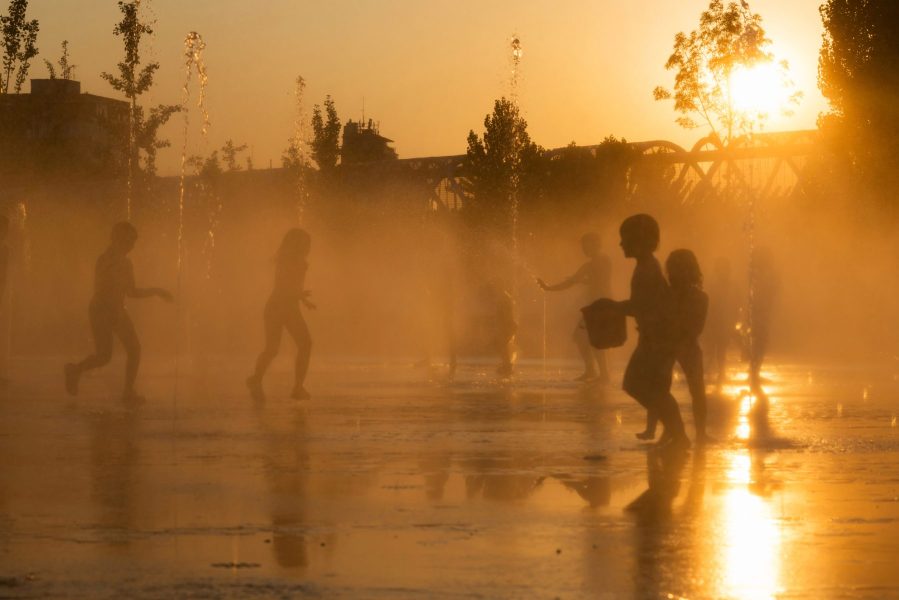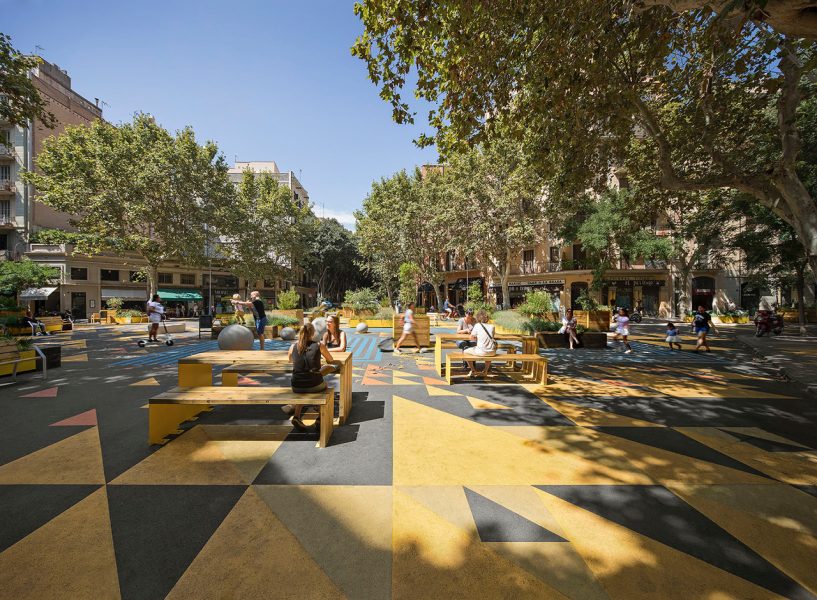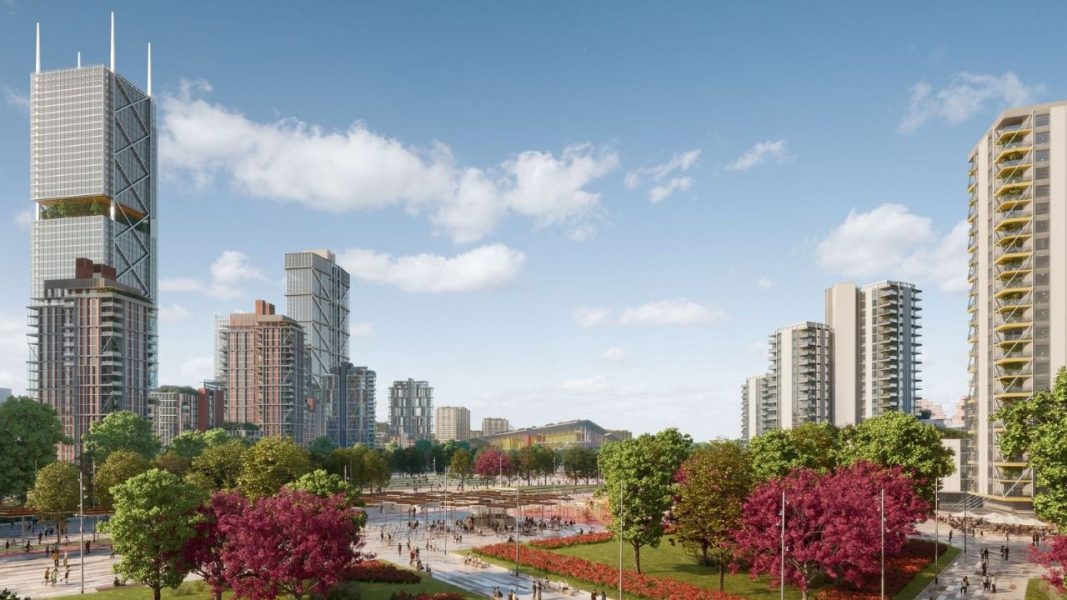27 September 2022
for Madrid Nuevo Norte

Rising temperatures in cities are closely related to urban design and motorised mobility. Madrid Nuevo Norte aims to be a solution to this problem that worsens every year.
Passive buildings, an urban network of geothermal energy, green roofs, porous pavements, sustainable drainage systems, alternative transport, and green areas will help reduce temperatures in the district and its surroundings.

Kids beat the heat in Madrid Río’s water jets, in the shadow of the Perrault bridge. Image: Andrés García M./iStock.
The first researcher to take an interest in increasing city temperatures was an Englishman named Luke Howard, who, in 1818 in London, a city still devoid of motor traffic, registered a difference of 2.2°C between the urban core and its surroundings overnight. Despite these early concerns, it was not until 1958, when another Englishman, climatologist Gordon Manley, first coined the term “Urban Heat Island”.
The Urban Heat Island (UHI) effect—higher temperatures within cities in contrast to those registered in the surrounding areas—is associated with four factors related to building and urban design, according to the trade journal Urban Land Institute, which published the Scorched: Extreme Heat and Real Estate report in 2019:
-Land use change: including the removal of trees and green spaces and the addition of materials that absorb heat during the day and release it at night.
-Residual heat: mainly from energy use in buildings (air conditioner, heating, electrical installations, etc.) and transportation.
-Air pollution: UHIs create ideal conditions for smog formation, which acts as a heat-trapping barrier, exacerbating the greenhouse effect.
-Urban geometry: the pattern in which streets and buildings are arranged, as well as the size and shape of a city, are influential determinants of UHI intensity.
The UHI effect in cities is associated with respiratory complications and heat stroke, conditions that are especially detrimental to the elderly and people with allergies, since substances like pollen reach higher levels in situations of extreme heat.
Madrid has a continental Mediterranean climate with very hot summers and very cold winters, factors that aggravate the heat island effect. According to a study by researchers at the Universidad Politécnica de Madrid on the behaviour of Madrid’s heat island and its impact on the energy consumption of buildings (based on measurements from 2015 and 2016), at night there may be simultaneous temperature variations of up to eight degrees at different points in the capital. The Detailed Study of Madrid’s Urban Climate (Estudio de Detalle del Clima Urbano de Madrid, 2016), prepared by the Madrid City Hall and the Universidad Autónoma de Madrid, details the heat island effect by zone.
Antonio Villanueva, industrial engineer and Building Physics Coordinator in the Architecture and Building department at IDOM, who specialises in energy efficiency and sustainability, explains that the differences are greater in summer than in winter and that temperatures are usually highest in the city centre relative to the surrounding areas, producing a bell effect. The effect also occurs at the height of buildings, meaning, the greater the proportion of visible sky, the faster the nocturnal cooling of surfaces irradiated during the day.
The goal of conducting thermal comparisons is to “attempt to explain what the temperature would be if the city did not exist”, says Villanueva. Some studies have confirmed the ability of green areas to mitigate UHIs, occasionally registering, for example, a temperature difference of up to five degrees inside and outside the Retiro Park, he explains.
There are uncontrollable aspects that increase the UHI effect, “such as the climate or orography of the land which, in some cases, like in Santiago de Chile, form a kind of crater that hinders air flow” says Villanueva. Others can be controlled, such as those having “to do with urban design, the adequate height and distance between buildings, the mix of green areas and paved areas, and an increase in porous surfaces”, Villanueva adds. Thus, he recommends using a new generation of permeable pavements for sidewalks, parking lots, road surfaces, and vehicular traffic areas, that guides the runoff to the subsoil rather than to the sewage system. This helps reintroduce rainwater—even the runoff from buildings—into the terrain, a major contribution from the sustainable urban draining systems featured new urban designs like Madrid Nuevo Norte.
“Madrid Nuevo Norte is an urban development that is taking this matter into account in a very serious way” says Villanueva, who affirms, “the district is practically a park where the areas between buildings will be green”. In addition, there is the “project’s commitment to porous pavements and green roofs, the rational distribution and height of buildings, and a reduction in motorised traffic given its dedication to alternative transport”. All of these elements will help make it “a district where the UHI effect is minimal”, Villanueva concludes.
To deter motor vehicle traffic, Madrid Nuevo Norte will employ a car park strategy (similar to London’s), which will consists of encouraging buildings to provide fewer parking spaces. Street parking will also be limited. “It’s a very brave approach, because the standards in Spain are still outdated,” notes Villanueva.

Superilla de Sant Antoni, one of the “super blocks” in Barcelona, where pedestrians and green spaces are prioritised to make the city friendlier. Project creator: Leku Studio. Image: Del Rio Bani.
Villanueva cites the example of Barcelona, which is working hard to refresh, re-green, and pedestrianize its grey areas, opting for green zones, promoting sustainable mobility, and expanding pedestrian areas with initiatives like “super blocks” (superilles) and climate shelters, where there is an abundance of shade, trees, and water. Both Paris and Madrid have occasionally cut traffic along major thoroughfares, such as the Champs Elysées and the Paseo del Prado, respectively. Other measures that Villanueva considers effective to curb traffic and achieve cleaner, cooler cities, include reducing the speed limit on city streets, implementing single-platform roadways, and reducing traffic lanes.
Villanueva anticipates that Madrid Nuevo Norte’s residential buildings will comply with Passivhaus standards, meaning, passive buildings with ventilated facades, solar protection, efficient insulation, green roofs, and lower energy needs, which will revert less heat to the city.
“Geothermal strategies will also be implemented so that energy exchanges, however few, do not use air from the outside, causing an increase in temperature, but from the ground”, which will serve as a large repository, balancing temperature discrepancies between summer and winter, Villanueva explains. Madrid Nuevo Norte will be equipped with an urban geothermal power network that will connect the buildings, enabling them to share energy and revert the excess to the ground.

Recreación del parque central que equilibrará la relación entre edificios y zonas verdes en el ámbito de Madrid Nuevo Norte y que se convertirá en nuevo espacio verde icónico que contribuirá a reducir el efecto isla de calor.
Madrid Nuevo Norte entails “one of the world’s most advanced landscaping projects”, says Villanueva. Because plant evapotranspiration plays a pivotal role in mitigating the UHI effect, the selection of vegetation that will adapt well to the local climate and the urban surroundings must be carried out by highly specialised professionals.
In summer, Madrid Nuevo Norte aims to cool open spaces near buildings with leafy trees, pergolas that create shade, and elements that provide moisture, such as fountains and water curtains. The aim in winter is to prevent drafts with the presence of deciduous trees that allow the light to pass through. Thus, the project creates winter and summer spaces adapted to Madrid’s extreme weather. Vegetation must include species that require little water, that capture substances like nitrogen dioxide and ozone to maintain optimal health levels, and that do not produce volatile organic compounds, according to one of Madrid Nuevo Norte’s master frameworks.
With the protected area of El Pardo nearby and a series of municipal initiatives underway to increase the city’s green infrastructure under the umbrella of Madrid Isla de Color (Madrid Colour Island), Madrid Nuevo Norte will be a green district that helps neighbouring areas benefit from this strategy to reduce the UHI effect, according to Villanueva. “The wind blows and when it blows toward Castellana, the full effect of the new vegetation will benefit the rest of the city”, affirms Villanueva, who believes that Madrid Nuevo Norte “will be a lung in the northern part of the city”.